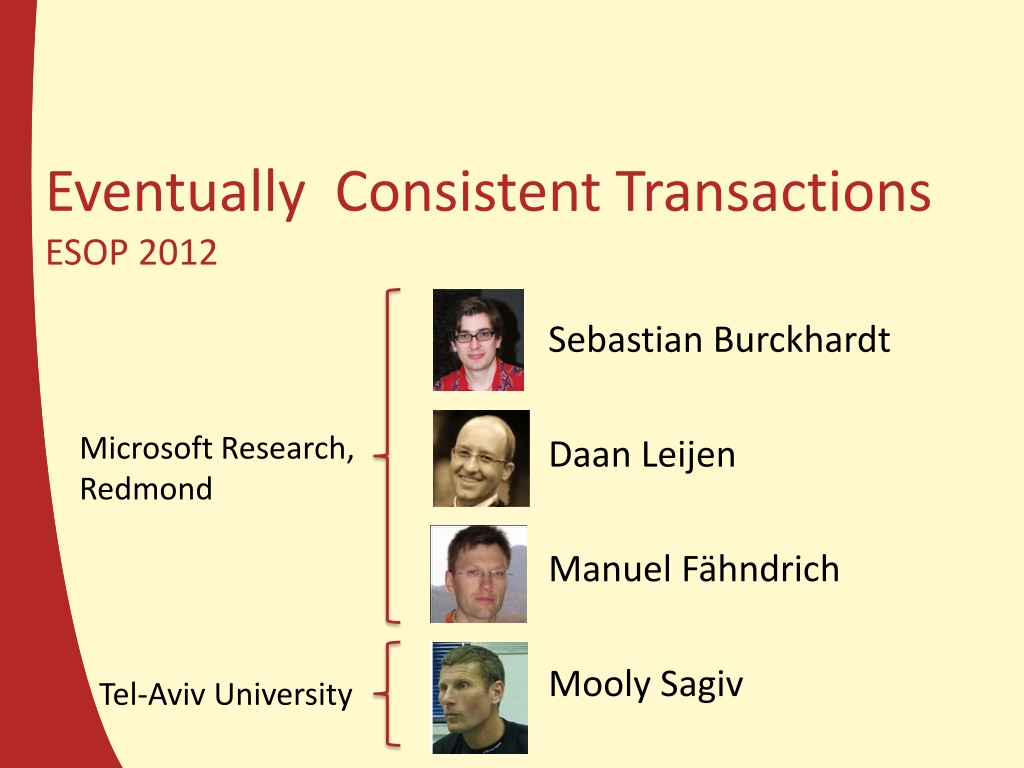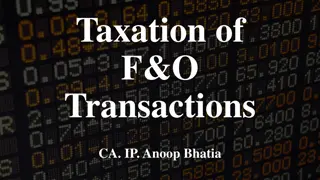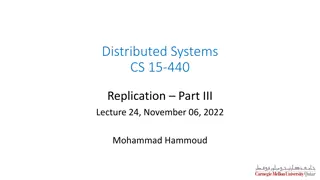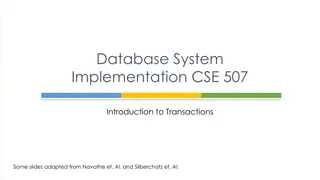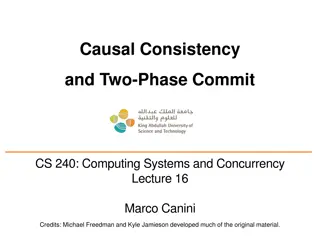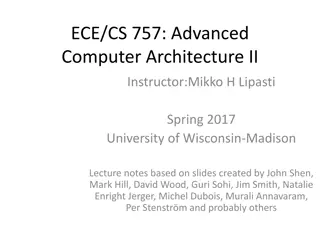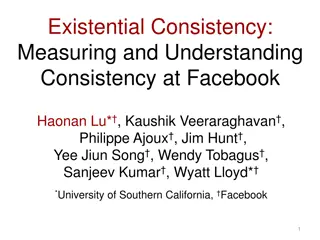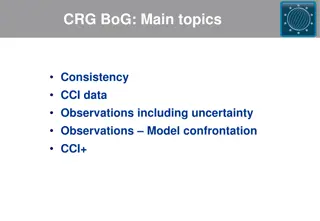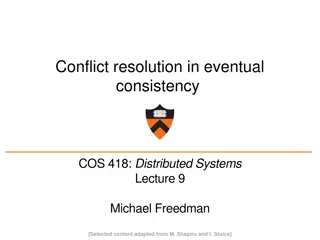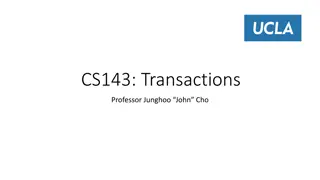Eventual Consistency Transactions Overview
Learn about eventual consistency transactions, CAP theorem compromises, and the need for different consistency models in distributed systems and web programming.
Download Presentation

Please find below an Image/Link to download the presentation.
The content on the website is provided AS IS for your information and personal use only. It may not be sold, licensed, or shared on other websites without obtaining consent from the author.If you encounter any issues during the download, it is possible that the publisher has removed the file from their server.
You are allowed to download the files provided on this website for personal or commercial use, subject to the condition that they are used lawfully. All files are the property of their respective owners.
The content on the website is provided AS IS for your information and personal use only. It may not be sold, licensed, or shared on other websites without obtaining consent from the author.
E N D
Presentation Transcript
Eventually Consistent Transactions ESOP 2012 Sebastian Burckhardt Microsoft Research, Redmond Daan Leijen Manuel F hndrich Mooly Sagiv Tel-Aviv University
Overview Motivation Why eventual consistency How we can understand and build it Operational consistency model Formal Foundation Axiomatic consistency model
Post-PC World: Apps & Cloud Favorites Chat Ratings Games Docs Comments Grocery List Household DBs Playlists Team DBs
The CAP theorem [Brewer00,Lynch&Gilbert02] A distributed system cannot have: Consistency all nodes see the same data at the same time Availability Every request receives a response about whether it was successful or failed Partition Tolerance the system continues to operate despite arbitrary message loss
Where to compromise? Strong Consistency, Brittle Availability Maintain illusion of single master copy Cannot commit updates without server roundtrip Changes are globally visible at time of commit Strong Availability, Eventual Consistency Keep replicas on each client Can commit updates locally without server connection Changes are immediately visible locally, and eventually propagated to all other replicas
How Much Consistency do we Need? Strong Consistency Updates are conditional on very latest state Examples: bank accounts, seat reservations, See: classic OLTP (online transaction processing) Eventual Consistency Updates are not conditional on very latest state Examples: Ratings, Shopping Cart, Comments, Settings, Chat, Grocery List, Playlist, Calendar, Mailbox, Contacts But: how to program this?
Eventual Consistency What does it really mean? Need a consistency model! At intersection of various communities Databases (relational storage, queries, ) Multiprocessors (memory models, consistency ) Distributed Systems (fault tolerance, availability) Web programming (client apps, web services)
Consistency Models Fall mostly into 2 categories Operational define valid executions as runs of an abstract machine Axiomatic define executions valid iff there exist certain relations, subject to certain conditions We do both in paper First, we define an abstract axiomatic model Generalization of sequential consistency Then, we define an operational model More specific and intuitive than the abstract model We prove that it implements the abstract model We will focus almost exclusively on the operational model in this talk.
Abstract System Model Client 3 Client 1 Client 2 Clients emit streams of transactions Each transaction contains a sequence of operations Operations are queries/updates of some data query query query query query update query update query query query query update update update query query query query query update query update update update update update update update update query query query
A familiar example of data: memory A random access memory interface (64 bits) Queries = {load(a) | a Addresses} Updates = {store(a,v) | a Addresses, v Values} Client 1 Client 2 store(A, 1) load(A) load(B) store(A, 2) store(B, 8) load(A) load(A)
Terminology History = collection of transaction sequences (one per client) including query results Example: Client 1 Client 2 store(17, 1) load(17) 1 load(19) 0 store(17, 2) store(19, 8) load(17) 2 load(17) 2 Consistency model = set of valid histories
Example Consider two clients performing a transaction to increment location A (initially 0) Under strong consistency, we would expect one of the following two histories Client 1 Client 2 Client 1 Client 2 load(A) 0 store(A, 1) load(A) 1 store(A, 2) load(A) 1 store(A, 2) load(A) 0 store(A, 1)
Example Now suppose clients are disconnected, yet still want to commit transactions. Transactions cannot be serializable (CAP theorem). Code does not work as intended. Client 1 Client 2 load(A) 0 store(A, 1) load(A) 0 store(A, 1) How can we understand such histories? How can we write correct programs?
Concurrent Revisions [OOPSLA 10] [WoDet 11] [ESOP 11] [OOSPLA 11] [ESOP 12] [ECOOP 12] 1. Model state as a revision diagram Fork: creates revision (snapshot) Queries/Updates target specific revision Join: apply updates to joining revision 2. Raise data abstraction level Record operations, not just states At join, replay all updates Use specially designed data types
Main Ingredient #1: REVISION DIAGRAMS
Revision Diagrams Directed Graphs One root One or more terminals Operational construction rules Fork One terminal -> two terminals Update/Query Append to terminal Join Two terminals -> one terminal Subject to join condition
Revision Diagrams Directed Graphs One root One or more terminals Operational construction rules Fork One terminal -> two terminals Update/Query Append to terminal Join Two terminals -> one terminal Subject to join condition
Revision Diagrams Directed Graphs One root One or more terminals Operational construction rules Fork One terminal -> two terminals Update/Query Append to terminal Join Two terminals -> one terminal Subject to join condition
Revision Diagrams Directed Graphs One root One or more terminals Operational construction rules Fork One terminal -> two terminals Update/Query Append to terminal Join Two terminals -> one terminal Subject to join condition
Revision Diagrams Directed Graphs One root One or more terminals Operational construction rules Fork One terminal -> two terminals Update/Query Append to terminal Join Two terminals -> one terminal Subject to join condition
Revision Diagrams Directed Graphs One root One or more terminals Operational construction rules Fork One terminal -> two terminals Update/Query Append to terminal Join Two terminals -> one terminal Subject to join condition
Revision Diagrams Directed Graphs One root One or more terminals Operational construction rules Fork One terminal -> two terminals Update/Query Append to terminal Join Two terminals -> one terminal Subject to join condition
Revision Diagrams Directed Graphs One root One or more terminals Operational construction rules Fork One terminal -> two terminals Update/Query Append to terminal Join Two terminals -> one terminal Subject to join condition
Revision Diagrams Directed Graphs One root One or more terminals Operational construction rules Fork One terminal -> two terminals Update/Query Append to terminal Join Two terminals -> one terminal Subject to join condition
Revision Diagrams Directed Graphs One root One or more terminals Operational construction rules Fork One terminal -> two terminals Update/Query Append to terminal Join Two terminals -> one terminal Subject to join condition
Revision Diagrams Directed Graphs One root One or more terminals Operational construction rules Fork One terminal -> two terminals Update/Query Append to terminal Join Two terminals -> one terminal Subject to join condition
Revision Diagrams Directed Graphs One root One or more terminals Operational construction rules Fork One terminal -> two terminals Update/Query Append to terminal Join Two terminals -> one terminal Subject to join condition
Revision Diagrams Directed Graphs One root One or more terminals Operational construction rules Fork One terminal -> two terminals Update/Query Append to terminal Join Two terminals -> one terminal Subject to join condition
Revision Diagrams Directed Graphs One root One or more terminals Operational construction rules Fork One terminal -> two terminals Update/Query Append to terminal Join Two terminals -> one terminal Subject to join condition
Revision Diagrams Directed Graphs One root One or more terminals Operational construction rules Fork One terminal -> two terminals Update/Query Append to terminal Join Two terminals -> one terminal Subject to join condition
Revision Diagrams Directed Graphs One root One or more terminals Operational construction rules Fork One terminal -> two terminals Update/Query Append to terminal Join Two terminals -> one terminal Subject to join condition
Revision Diagrams Directed Graphs One root One or more terminals Operational construction rules Fork One terminal -> two terminals Update/Query Append to terminal Join Two terminals -> one terminal Subject to join condition
Revision Diagrams Directed Graphs One root One or more terminals Operational construction rules Fork One terminal -> two terminals Update/Query Append to terminal Join Two terminals -> one terminal Subject to join condition
Semantics State determined by sequence of updates along path from root Operations are replayed at tip of arrow. store(A, 1) store(B, 1) load(A) 0 store(A, 1) load(A) 1 load(B) 1
Semantics No updates along path -> sees initial state State determined by sequence of updates along path from root Updates are replayed at tip of arrow. store(A, 1) store(B, 1) load(A) 0 store(A, 1) load(A) 1 load(B) 1
Semantics State determined by sequence of updates along path from root Updates are replayed at tip of arrow. store(A, 1) store(B, 1) load(A) 0 store(A, 1) store(A,1) store(B,1) store(A,1) load(A) 1 load(B) 1
Revision Consistency A history is revision consistent if we can place the transactions on a revision diagram s.t. Query results are consistent with revision state There is a path between successive transactions Committed transactions have a path to all but finitely many vertices Client 1 Client 2 store(A, 1) store(B, 1) load(A) 0 store(A, 1) load(A) 0 store(A,1) store(A, 1) store(B, 1) load(A) 1 load(B) 1 load(A) 1 load(B) 1
Revision Consistency Guarantees Transactions don t fail Atomicity Other clients see either all or none of the updates of a transactions Isolation Updates by incomplete transactions are not visible to other clients See own Updates Client sees effect of all updates it has performed up to this point Eventual Consistency Completed Transactions eventually settle at a certain position within a common history prefix. Causality If B sees updates of A, and C sees updates of B, then C sees updates of A This one required work to prove.
The join condition Revision diagrams are subject to the join condition: A revision can only be joined into vertices that are reachable from the fork. Invalid join, no path from fork.
Without join condition, causality is violated. B sees updates of A C sees updates of B But C does not see updates of A A B Visibility is not transitive. We prove in paper: enforcing join condition is sufficient to guarantee transitive visibility. C
Main Ingredient #2: RAISE DATA ABSTRACTION
Raise Data Abstraction Richer data types enable updates that behave better Integer example: Queries = {load(a)} Updates = {store(a,v)} {add(a,v)} load(A) 0 add(A, 1) load(A) 0 add(A, 1) load(A) 2
Query-Update Automata (QUA) A query-update interface tuple (Q, V, U) Q Query operations V Values returned by query U Update operations A query update automaton (S, s0, #) over (Q, V, U) A set of states S An initial state s0 S For each q in Q, an interpretation q : S V For each u in U, an interpretation u : S S
Why QUAs ? QUAs keep the conversation general QUAs can represent simple shared memory QUAs can represent abstract data types QUAs can represent entire databases QUAs provide what we need to define EC Clean separation of queries (no side effects) and updates (only side effects, no return value) Updates contain information about intent, and are total functions (can apply to different state) QUAs can enable optimized implementations Bounded metadata, not unbounded logs
A fork-join QUA Rather than maintaining update logs or walking graphs, we can use an FJ-QUA to represent the state of a revisions A fork-join QUA is a tuple ( , 0, f, j, #) An initial state 0 For each q in Q, an interpretation q : S V For each u in U, an interpretation u : S S A fork operation f: A join operation j:
Programming with FJ-QUAs [ECOOP 12, to appear] No need to develop custom FJ-QUAs for each application: programmer can compose them Support FJ-QUAs for basic types Cloud Integers Cloud Strings Support FJ-QUAs for certain collection types Cloud Entities Cloud Arrays
System Models Revision diagrams are a visualization tool; actual system can use a variety of implementations Paper gives several system models. Since revisions can be nested, we can use server pools to scale to large numbers of clients.
Sequential Consistency, Formally A history H is sequentially consistent if there exists a partial order < on EH such that < extends program order <p (atomicity) < factors over transactions < is a total order on past events (e1 < e) (e2 < e) (e1 < e2) (e2 < e1) (e2 = e1) All query results (q, v) EH are consistent with < v = q (uk (uk-1 (u1 (s0))) u1 < u2 < < uk < (q, v) (isolation) if e1 < e2 and e1 is not committed then e1 <p e2 (eventual delivery) For all committed transactions t there exists only finitely many transactions t such that not t < t
